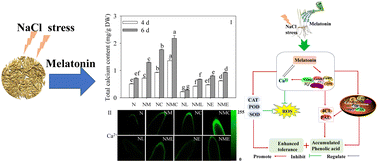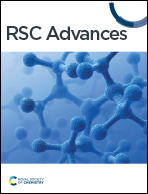Mechanism of calcium in melatonin enhancement of functional substance-phenolic acid in germinated hulless barley†
Abstract
Phenolic acid is a physiologically active substance that has a variety of effects on humans. Barley sprouts are often used as food ingredients to enrich phenolic acids and to further produce functional foods rich in phenolic acids. In this study, the mechanism of Ca2+ involvement in regulating phenolic acid biosynthesis and plant growth in barley by melatonin (MT) under NaCl stress was investigated. According to the studies, MT (25 μM) increased total calcium content, induced Ca2+ burst, and up-regulated the gene expression of calcium-regulated protein-dependent protein kinase and calcium-binding protein transcription-activating protease in NaCl-stressed (60 mM) barley. Exogenous MT and its combined CaCl2 (0.4 mM) significantly promoted phenolic acid biosynthesis by increasing the activity of C4H and PAL, and induced gene expression of PAL and F5H. The addition of exogenous CaCl2 and MT caused systemic tolerance in NaCl-stressed barley, as determined by a decrease in the fluorescence intensity of hydrogen peroxide and oxygen radical anions as well as an enhancement in the antioxidant enzyme, thus significantly increasing sprout length and fresh weight. In addition, combined use of MT with Ca2+ antagonists (lanthanum chloride or ethylene glycol tetraacetic acid), impaired all impacts as mentioned above. These findings imply that Ca2+ participated in MT-induced phenolic acid biosynthesis and growth improvement in NaCl-stressed barley.



 Please wait while we load your content...
Please wait while we load your content...